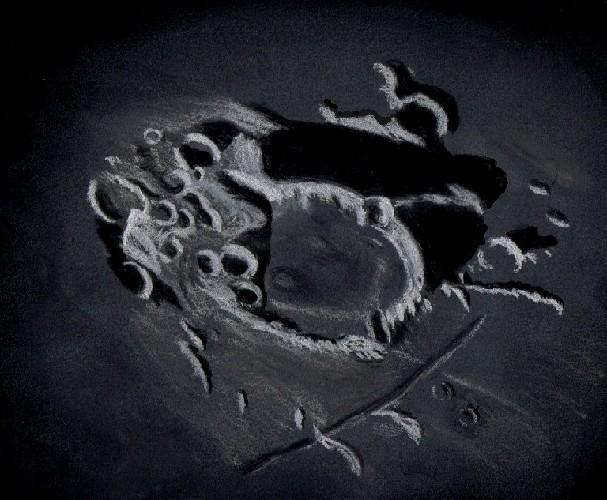Capuanus at the Marsh of Epidemics
By Frank McCabe
At my geographic location during the fall, it is not uncommon to have a sequence of days with fog and mist under heavy cloud cover. At sunset the fog lifted and the sky cleared. It was time to take advantage of this break to observe and sketch.
The sketching target I chose near the terminator is Pre-Imbrian era crater Capuanus. This ancient crater rests on the shore of Palus Epidemiarum. At 58 kilometers in diameter, this is a large crater with extensive rim damage from multiple crater impacts. A narrow gap in the low north wall nearly connects the crater floor to the marsh. Brightly illuminated in the rising sun is the high western wall which towers at 2.5 kilometers above the crater floor. The basaltic lava on the floor of the crater appeared mostly dark. Two of the domes or dome-like rises could be detected on the southern crater floor. These volcanoes were active during the age of prokaryotic life here on earth 3.5 billion years ago. Ridges extending from the west of the crater, line up nicely with the margins of both mare Nubium and mare Humorum. Perhaps these are remains of a basin rim which was part of one of these seas.Across the floor of Palus Epidemiarum a wide segment of western Rima Hesiodus could be seen approaching the northern most of these ridge reminants. Two hours after I began sketching clouds moved in and closed my window on the moon.
Sketching:
For this sketch I used: black Strathmore 400 Artagain paper, 9”x12”, white and black Conte’pastel pencils and a blending stump. Brightness was slightly decreased after scanning.
Telescope: 10 inch f/5.7 Dobsonian and 4mm eyepiece 362x
Date: 11-20-2007 0:05-1:40 UT
Temperature: 14°C (58°F)
fog, calm
Seeing: Antoniadi III
Co longitude: 33°
Lunation: 10 days
Illumination: 72.2 %
Frank McCabe

